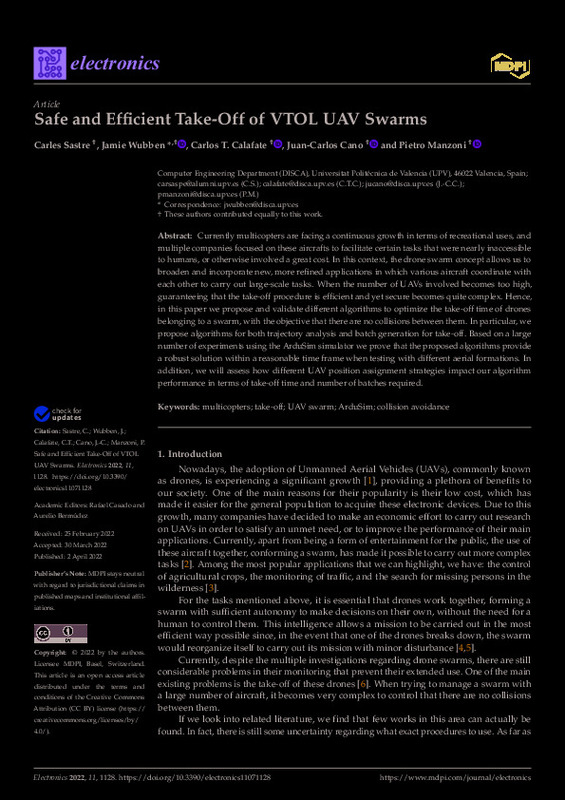JavaScript is disabled for your browser. Some features of this site may not work without it.
Buscar en RiuNet
Listar
Mi cuenta
Estadísticas
Ayuda RiuNet
Admin. UPV
Safe and Efficient Take-Off of VTOL UAV Swarms
Mostrar el registro sencillo del ítem
Ficheros en el ítem
| dc.contributor.author | Sastre, Carles
|
es_ES |
| dc.contributor.author | Wubben, Jamie
|
es_ES |
| dc.contributor.author | Tavares De Araujo Cesariny Calafate, Carlos Miguel
|
es_ES |
| dc.contributor.author | Cano, Juan-Carlos
|
es_ES |
| dc.contributor.author | Manzoni, Pietro
|
es_ES |
| dc.date.accessioned | 2023-05-08T18:01:51Z | |
| dc.date.available | 2023-05-08T18:01:51Z | |
| dc.date.issued | 2022-04 | es_ES |
| dc.identifier.uri | http://hdl.handle.net/10251/193202 | |
| dc.description.abstract | [EN] Currently multicopters are facing a continuous growth in terms of recreational uses, and multiple companies focused on these aircrafts to facilitate certain tasks that were nearly inaccessible to humans, or otherwise involved a great cost. In this context, the drone swarm concept allows us to broaden and incorporate new, more refined applications in which various aircraft coordinate with each other to carry out large-scale tasks. When the number of UAVs involved becomes too high, guaranteeing that the take-off procedure is efficient and yet secure becomes quite complex. Hence, in this paper we propose and validate different algorithms to optimize the take-off time of drones belonging to a swarm, with the objective that there are no collisions between them. In particular, we propose algorithms for both trajectory analysis and batch generation for take-off. Based on a large number of experiments using the ArduSim simulator we prove that the proposed algorithms provide a robust solution within a reasonable time frame when testing with different aerial formations. In addition, we will assess how different UAV position assignment strategies impact our algorithm performance in terms of take-off time and number of batches required. | es_ES |
| dc.description.sponsorship | This work is derived from R&D project RTI2018-096384-B-I00, funded by MCIN/AEI/ 10.13039/501100011033 and "ERDF A way of making Europe". | es_ES |
| dc.language | Inglés | es_ES |
| dc.publisher | MDPI AG | es_ES |
| dc.relation.ispartof | Electronics | es_ES |
| dc.rights | Reconocimiento (by) | es_ES |
| dc.subject | Multicopters | es_ES |
| dc.subject | Take-off | es_ES |
| dc.subject | UAV swarm | es_ES |
| dc.subject | ArduSim | es_ES |
| dc.subject | Collision avoidance | es_ES |
| dc.subject.classification | ARQUITECTURA Y TECNOLOGIA DE COMPUTADORES | es_ES |
| dc.title | Safe and Efficient Take-Off of VTOL UAV Swarms | es_ES |
| dc.type | Artículo | es_ES |
| dc.identifier.doi | 10.3390/electronics11071128 | es_ES |
| dc.relation.projectID | info:eu-repo/grantAgreement/AEI/Plan Estatal de Investigación Científica y Técnica y de Innovación 2017-2020/RTI2018-096384-B-I00/ES/SOLUCIONES PARA UNA GESTION EFICIENTE DEL TRAFICO VEHICULAR BASADAS EN SISTEMAS Y SERVICIOS EN RED/ | es_ES |
| dc.rights.accessRights | Abierto | es_ES |
| dc.contributor.affiliation | Universitat Politècnica de València. Escola Tècnica Superior d'Enginyeria Informàtica | es_ES |
| dc.contributor.affiliation | Universitat Politècnica de València. Departamento de Informática de Sistemas y Computadores - Departament d'Informàtica de Sistemes i Computadors | es_ES |
| dc.description.bibliographicCitation | Sastre, C.; Wubben, J.; Tavares De Araujo Cesariny Calafate, CM.; Cano, J.; Manzoni, P. (2022). Safe and Efficient Take-Off of VTOL UAV Swarms. Electronics. 11(7):1-29. https://doi.org/10.3390/electronics11071128 | es_ES |
| dc.description.accrualMethod | S | es_ES |
| dc.relation.publisherversion | https://doi.org/10.3390/electronics11071128 | es_ES |
| dc.description.upvformatpinicio | 1 | es_ES |
| dc.description.upvformatpfin | 29 | es_ES |
| dc.type.version | info:eu-repo/semantics/publishedVersion | es_ES |
| dc.description.volume | 11 | es_ES |
| dc.description.issue | 7 | es_ES |
| dc.identifier.eissn | 2079-9292 | es_ES |
| dc.relation.pasarela | S\460127 | es_ES |
| dc.contributor.funder | Agencia Estatal de Investigación | es_ES |
| dc.contributor.funder | European Regional Development Fund | es_ES |








